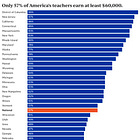Pre-Test/Post-Test and School Funding in Tennessee
No matter the formula, the results are the same

Determining the effectiveness of a policy intervention requires understanding desired outcomes. That is, what was happening before the policy intervention and what is happening since the intervention.
Is the policy getting us closer to our goal, are things staying the same, or are we getting further away?
In the academic world, testing an intervention is often done using the pre-test/post-test method.
Students take a test to establish a baseline. This is where they are before a particular unit of instruction. Then, the instruction happens. At the end, students take the same test.
The results help determine the effectiveness of the lessons (and expose any potential gaps). If the instruction “worked,” students should score higher on the post-test. The results should demonstrate improvement.
Likewise, after a policy intervention, policymakers (and the public who pays for the policy implementation) should expect improved outcomes.
Which brings me to school funding “reform” in Tennessee.
For 30 years, Tennessee public schools were funded under a formula known as the Basic Education Plan (BEP).
The formula used a complex series of weights to determine both the amount of money the state would contribute to local school systems and the amount local governments should put in to support those schools.
The formula was widely praised for a focus on equity.
However, after the initial six years of the formula, there was significant debate about adequacy - the state simply wasn’t meeting its obligation.
Two additional lawsuits were filed and each time, the state was found to be failing to meet the funding burden spelled out in the BEP.
A third suit was pending back in 2020 - but that suit was later dropped as Gov. Lee and lawmakers made promises to address funding formula reform.
The essence of that 2020 suit was that the state was not adequately funding schools.
In fact, reports suggested Tennessee was coming up short by nearly $2 billion.
Analysis of investment in schools in Tennessee found that while the state’s funding formula was relatively fair, it simply wasn’t being well-funded.
The state ranked in the bottom 5 in the country in both investment in schools (as measured by per pupil spending) and teacher compensation.
That’s the pre-test.
Tennessee schools lacking adequate funds. Tennessee teachers struggling with low pay.
In 2022, though, the state did pass Gov. Lee’s new education formula. 30 years after its inception, the BEP would be no more.
The new formula, TISA, would save the day.
So, what’s the post-test say?
The latest analysis by the Education Law Center - the same group that gave Tennessee grades of “F” in both funding level and funding effort back in 2021 - shows that in 2024, Tennessee earns an “F” in both funding level and funding effort.
The state is still in the bottom 5 in the nation in investment in schools. The state’s teachers are not only among the lowest paid in the nation, they are some of the lowest-paid in the Southeast (teachers in both Kentucky and Alabama earn more).
The ELC did note the state’s funding formula is slightly more equitable than the old BEP. So, that’s good.
But, all that equitable distribution of an inadequate funding pot still leaves districts and their students starving for resources.
Yes, it is still early in the TISA era.
So far, though, the state is failing. The post-test results suggest Bill Lee’s TISA intervention lacks the substance (funding) necessary to achieve desired results.




Is it a coincidence that Tennessee has much lower tax rates than other states? I have heard it described as a great place to retire to avoid state taxes.
Education Law Center! I love that they were cited; it is an organization I admire.